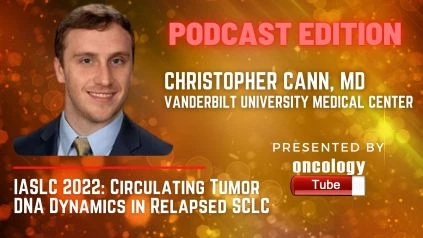Christopher Cann, MD, Clinical Fellow, Division of Hematology/Oncology, Department of Medicine at Vanderbilt University Medical Center. In this video, he speaks about the IASLC 2022 Abstract – Circulating Tumor DNA Dynamics in Relapsed Small Cell Lung Cancer Are Predictive of Progression-Free and Overall Survival.Â
Origins:
Relapsed small cell lung cancer (SCLC) is difficult to treat, with low overall survival and objective response rates (ORR) (OS). ORR is currently predicted to be 25-50 percent for platinum-sensitive illness and 10-20 percent for platinum-resistant disease, resulting in a short progression-free survival (PFS) of 4-5 months and an OS of less than one year from the onset of relapse. Because of this intrinsic chemoresistance, selecting the best cytotoxic chemotherapy regimen in this situation is extremely difficult. Individual patient chemosensitivity data can be collected in-vivo by assessing changes in circulating tumor DNA (ctDNA) levels following the initial dose of cytotoxic treatment, we reasoned.
Methodologies:
A plasma-based ctDNA assay developed previously was used to sequence 14 frequently mutated genes in SCLC (TP53, RB1, BRAF, KIT, NOTCH1-4, PIK3CA, PTEN, FGFR1, MYC, MYCL1, and MYCN) on 13 patients with relapsed SCLC who were eligible for additional systemic therapy (second (n = 6) or third-line (n = 7) therapy.
Rovalpituzumab tesirine (n=2), a checkpoint kinase 1 inhibitor (n=1), a platinum doublet (n=1), or paclitaxel (n=2) were used as second-line treatments. Rovalpituzumab tesirine (n=1), checkpoint kinase 1 inhibitor (n=1), irinotecan (n=1), or paclitaxel (n=4) were used as third-line treatments.
Each patient provided a pre-treatment ctDNA sample as well as at least one post-treatment sample. The difference in ctDNA peak variant allele frequency (VAF) between pre-treatment and first-on-treatment samples was calculated for each patient, and ORR, PFS, and OS were estimated.
Findings:
In our 13-patient sample, 5 (38%) had an objective response, with patients who had a larger than 0.1 percent rise in peak VAF at the initial on-treatment ctDNA measurement receiving no radiographic response to therapy (stable disease (n=2), disease progression (n=1). Notably, patients who had ctDNA clearance at the first on-treatment ctDNA assessment (n=3) had significantly longer median PFS and OS than those who had persisting signs of ctDNA (PFS: 170 days vs 85.5 days, OS: 337 days vs 123.5 days, respectively).
Outcome:
Early clearance of ctDNA predicts an improvement in PFS and OS in patients with recurrent SCLC, but an early increase in peak VAF indicated chemoresistance. Bigger cohorts are required to corroborate this discovery, and we are now gathering additional patients and samples for a larger study.

